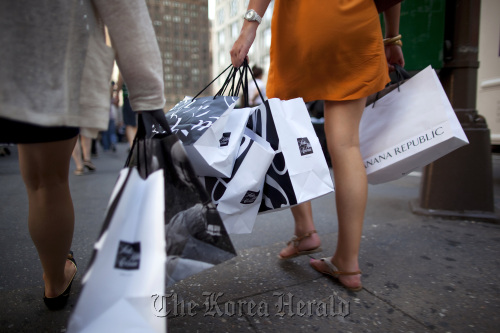Falling energy costs temper price rises; Americans pay more for cars, clothing and hotels
WASHINGTON (AP) ― Falling energy prices cooled overall inflation in May, offering some relief to consumers who have been coping for months with high gas prices.
Consumer prices rose 0.2 percent, the smallest increase in six months, the Labor Department said. It was the first drop in energy costs in nearly a year.

Still, Americans paid more for cars, clothing and hotel rooms in May. That drove so-called “core” consumer prices, which exclude volatile food and energy, up by the most in nearly three years.
The increase in core inflation, which was higher than analysts expected, contributed to another bleak day on Wall Street. The Dow Jones industrial average tumbled 179 points, reflecting fears that the worsening debt crisis in Greece could spread.
Higher core prices will limit the ability of the Federal Reserve to take any additional steps to stimulate the economy. The Fed is wrapping up a $600 billion Treasury bond-buying program this month that was intended to lower interest rates, boost stock prices, and encourage more spending.
Critics have charged that the bond purchases could stoke inflation by increasing the amount of money in circulation. Rising core inflation will strengthen the hands of those Fed officials opposed to any further purchases.
Economists downplayed the increase in core prices. Auto prices will likely fall as the impact of supply disruptions from Japan fades and production picks up. And the big rise in hotel costs likely reflected a one-time increase before the summer travel season.
Most important, they noted, is that consumers are finally getting some relief from high gas prices. Prices have fallen by nearly 30 cents since peaking last month at a national average of $3.98 per gallon.
 |
Pedestrians carry shopping bags in New York. (Bloomberg) |
Inflation “is probably now close to peaking,” said Paul Ashworth, an economist at Capital Economics. “While the bigger monthly rise in core prices is a concern, a lot of it was due to temporary factors that could be reversed in the next few months.”
A separate report from the Federal Reserve showed that U.S. factories produced more business equipment and construction materials last month. That boosted manufacturing output 0.4 percent last month and followed a decline in April, the first after 10 months of increases.
Overall industrial production was essentially flat in May for the second month in a row. It was held back by a decline in utility activity caused by milder spring weather.
Ashworth said the report confirms that the April decline in factory output was an outlier. The March 11 earthquake in Japan created a parts shortage that affected U.S. car makers. And tornadoes in the U.S. slowed factory output in the South. Ashworth said factories are back to increasing production. But the rate of growth has slowed since last year.
“Things seem to be getting back to normal in Japan, so supply disruptions should ease up and it should unwind itself,” Ashworth said.
Economists expect factory output to keep growing in the coming months as Japanese automakers, such as Toyota and Honda, bring production at their U.S. plants back to pre-earthquake levels. Full production likely won’t be restored until fall.
Other reports Wednesday show the economy, for now, is still weak. A survey of manufacturers in the New York region found that activity slowed in June. The New York Federal Reserve’s Empire State index fell to -7.8, down from 12 the previous month. Any reading below zero indicates that the sector is shrinking.
And homebuilders are getting even more pessimistic, according to a report from the industry’s trade group. An index that measures builders’ sentiment fell to 13 in June. That’s the lowest level in nine months and just five points about the record low, reached in January 2009.
Some inflation can be healthy for the economy because it encourages people to spend and invest rather than sitting on their cash. More spending drives corporate growth, which makes businesses more likely to hire people.
But higher food and gas prices have hurt growth this year. Consumers have had to spend more at the grocery stores and to fill their tanks, leaving less money for spending on other goods and services, like appliances, furniture and vacations, that drive the economy.
Federal Reserve Chairman Ben Bernanke has said that the rise in food and gas prices would likely be temporary. The latest readings on consumer and wholesale inflation seem to support that view.
In addition to the drop in consumer gas prices, the government reported this week that wholesale food prices fell in May by the most in nearly a year. Much of that decline resulted from a sharp fall in vegetable and fruit prices. Most economists expect overall food prices to stabilize later this year.
Consumer prices rose 3.6 percent from June 2010 through May 2011, the biggest one-year gain since October 2008. The yearly gain in the index was only 1.1 percent as recently as November.
Excluding the volatile food and energy categories, which account for about 20 percent of the index, core prices rose only 1.5 percent in that same period. That’s below the Federal Reserve’s informal inflation target of about 2 percent.
Autos and apparel drove core consumer prices higher in May. New car prices rose 1.1 percent last month, after rising 0.7 percent in April. Auto dealers have fewer popular fuel-efficient models on their lots because of the supply disruptions. As a result, they are offering fewer deals to boost sales.
Clothing rose 1.2 percent in May, a result of higher cotton prices and increasing labor costs overseas, where most U.S. apparel is made.









